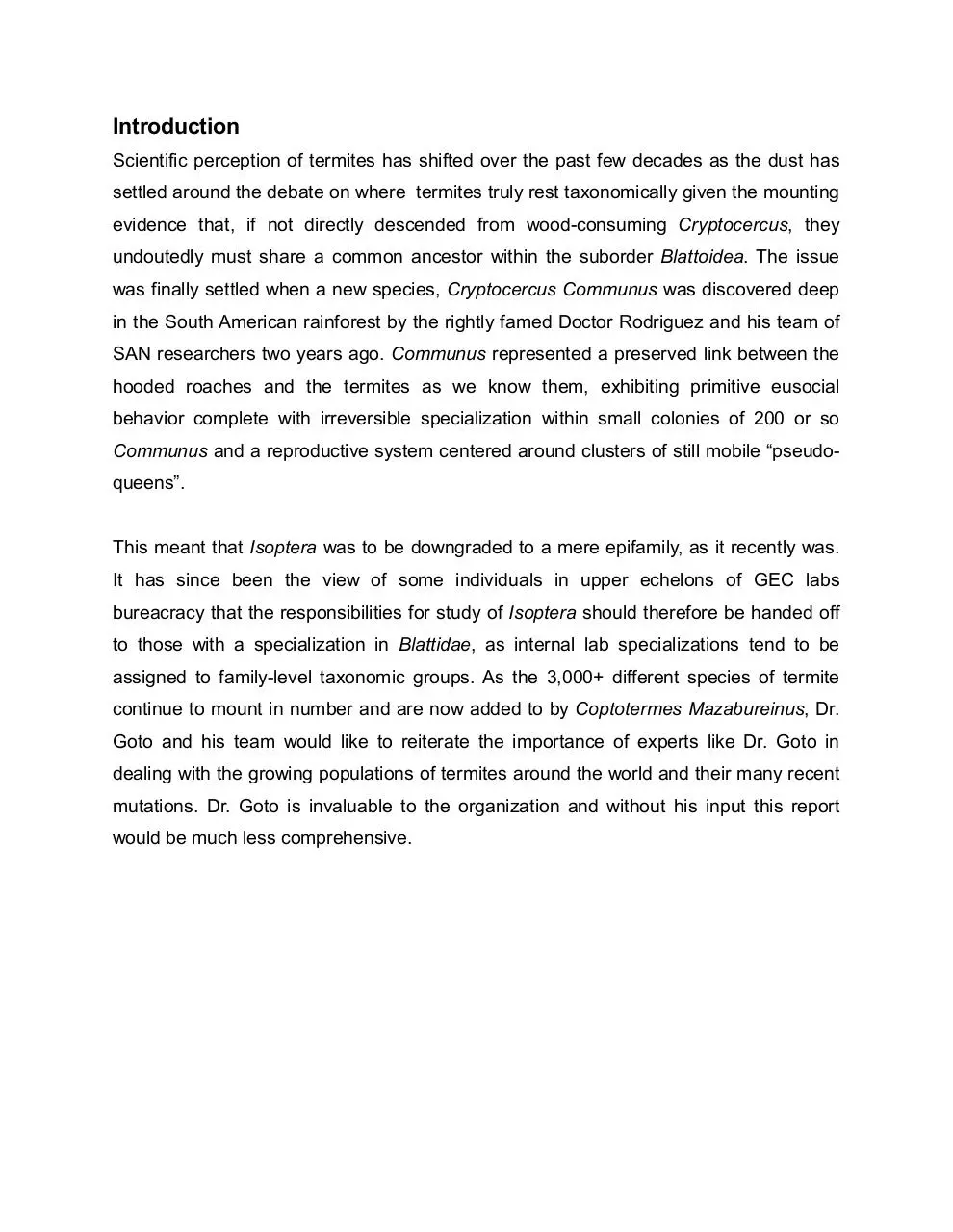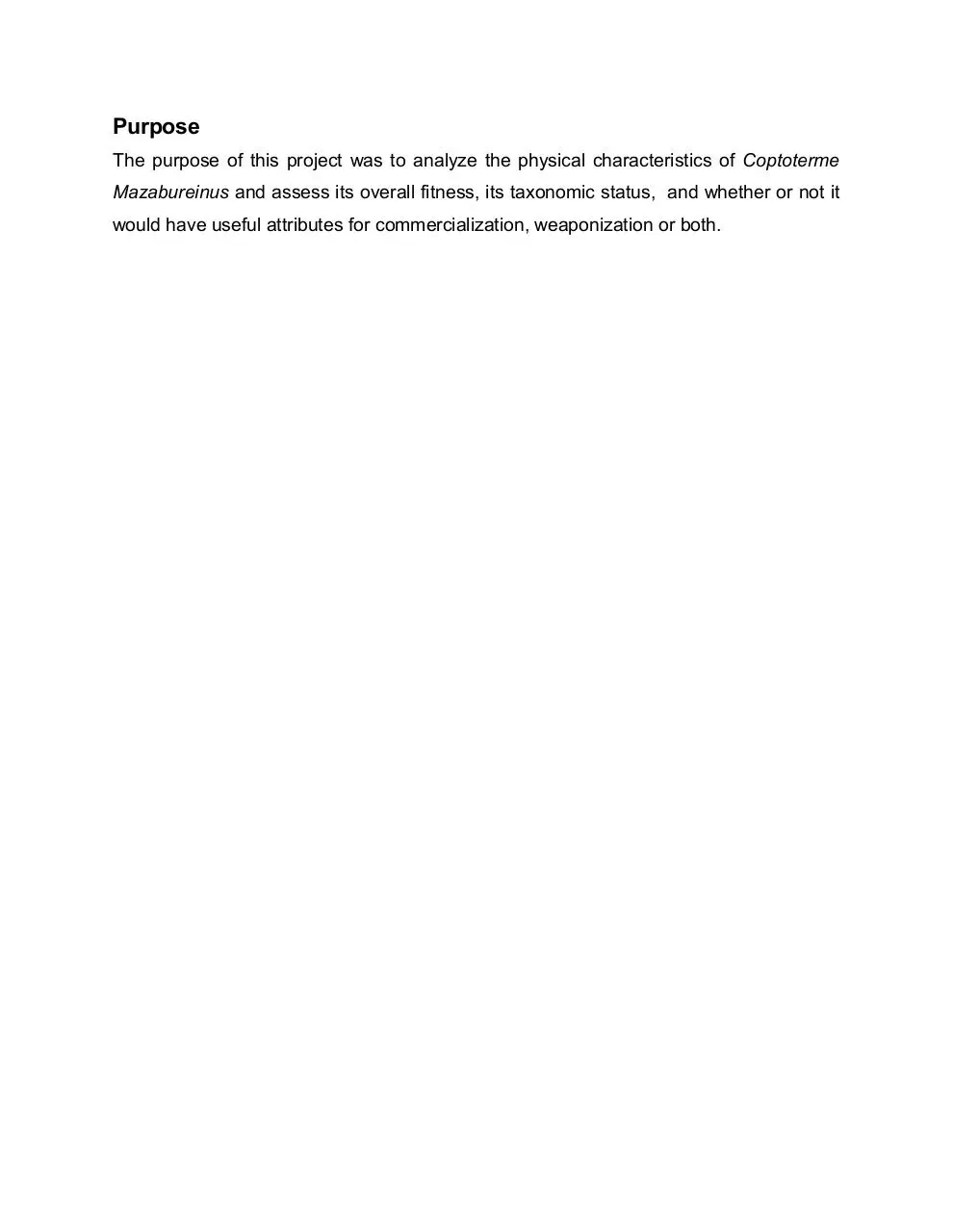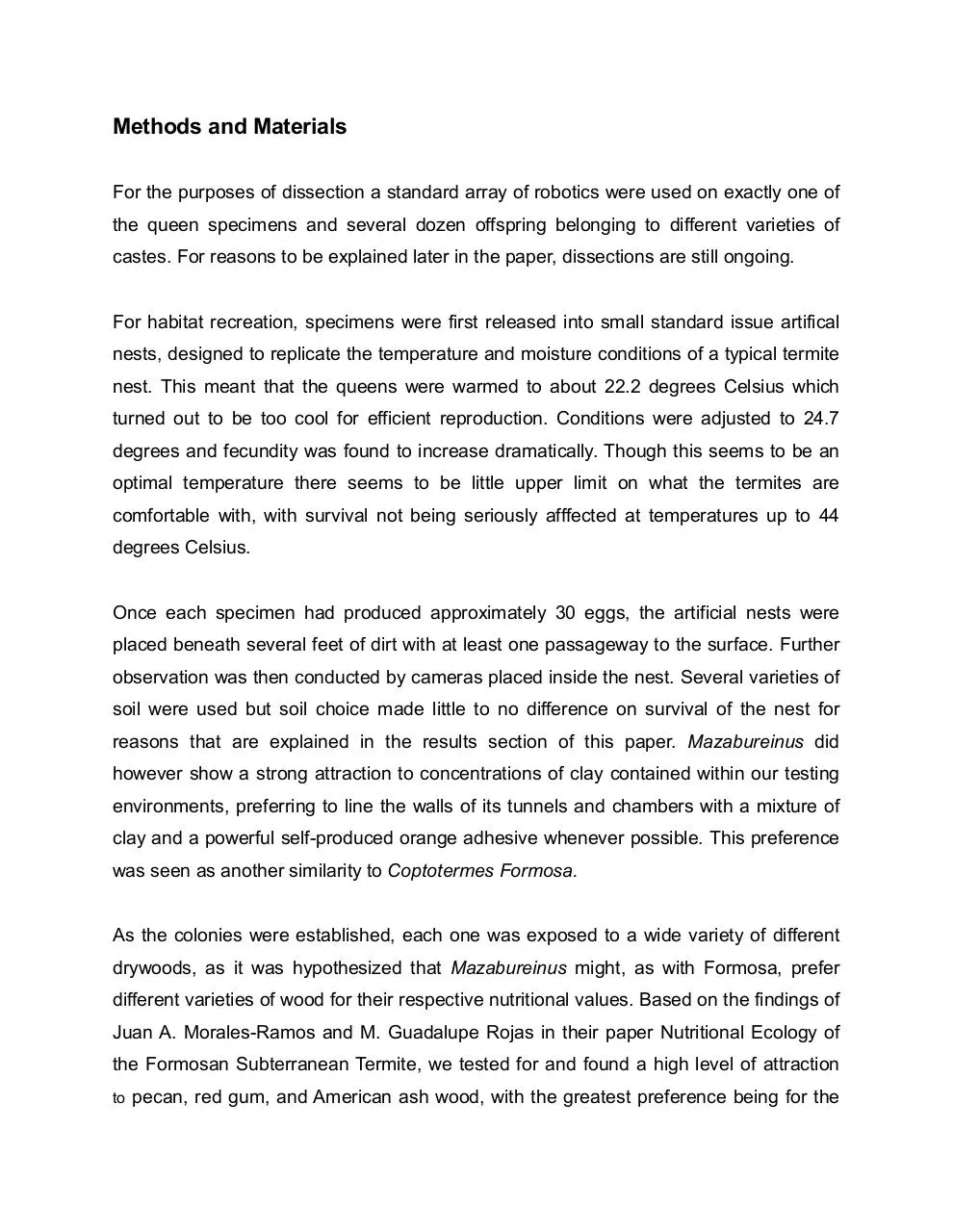termitecompile (PDF)
File information
Title: Cover
This PDF 1.4 document has been generated by / Qt 4.8.5 (C) 2011 Nokia Corporation and/or its subsidiary(-ies), and has been sent on pdf-archive.com on 01/12/2015 at 05:30, from IP address 104.246.x.x.
The current document download page has been viewed 704 times.
File size: 62.9 KB (11 pages).
Privacy: public file





File preview
Preliminary Report On The
Discovery And Analysis Of
Coptotermes Mazabureinus
Doctor Emilio Goto, PhD., Chief Entomologist
Assisted by Clarissa Jones, PhD., Gerry Callis, PhD., and Fu Yun, PhD.
Global Exterminators Corporation Labs, Hong Kong Branch
Abstract
Following the capture and retrieval of seven queens by an employee in the field, we
have identified a new species of termite and taken the liberty of naming it Coptotermes
Mazabureinus, after the Japanese phrase for “large headed mother” as suggested by
Dr. Jones. While initial readings of the debrief led us to suspect that the termite
infestation on Vice-Administrator Shan’s property represented just another example of
Coptoterme Formosa (the so-called “super termite”) at work but the even more extreme
physogastrism visible in the presented specimens quickly put that assumption to rest.
Dr. Jones and Dr. Goto both speculated that based on the extension of the epicuticle,
these specimens were likely already several years old and set about testing their levels
of fecundity and trying to recreate the subterranean conditions which the termites were
originally found in, so as to generate a good nesting environment. Dr. Callis and Dr. Yun
performed genetic testing to verify the termite’s status as a new species.
Introduction
Scientific perception of termites has shifted over the past few decades as the dust has
settled around the debate on where termites truly rest taxonomically given the mounting
evidence that, if not directly descended from wood-consuming Cryptocercus, they
undoutedly must share a common ancestor within the suborder Blattoidea. The issue
was finally settled when a new species, Cryptocercus Communus was discovered deep
in the South American rainforest by the rightly famed Doctor Rodriguez and his team of
SAN researchers two years ago. Communus represented a preserved link between the
hooded roaches and the termites as we know them, exhibiting primitive eusocial
behavior complete with irreversible specialization within small colonies of 200 or so
Communus and a reproductive system centered around clusters of still mobile “pseudo-
queens”.
This meant that Isoptera was to be downgraded to a mere epifamily, as it recently was.
It has since been the view of some individuals in upper echelons of GEC labs
bureacracy that the responsibilities for study of Isoptera should therefore be handed off
to those with a specialization in Blattidae, as internal lab specializations tend to be
assigned to family-level taxonomic groups. As the 3,000+ different species of termite
continue to mount in number and are now added to by Coptotermes Mazabureinus, Dr.
Goto and his team would like to reiterate the importance of experts like Dr. Goto in
dealing with the growing populations of termites around the world and their many recent
mutations. Dr. Goto is invaluable to the organization and without his input this report
would be much less comprehensive.
Purpose
The purpose of this project was to analyze the physical characteristics of Coptoterme
Mazabureinus and assess its overall fitness, its taxonomic status, and whether or not it
would have useful attributes for commercialization, weaponization or both.
Methods and Materials
For the purposes of dissection a standard array of robotics were used on exactly one of
the queen specimens and several dozen offspring belonging to different varieties of
castes. For reasons to be explained later in the paper, dissections are still ongoing.
For habitat recreation, specimens were first released into small standard issue artifical
nests, designed to replicate the temperature and moisture conditions of a typical termite
nest. This meant that the queens were warmed to about 22.2 degrees Celsius which
turned out to be too cool for efficient reproduction. Conditions were adjusted to 24.7
degrees and fecundity was found to increase dramatically. Though this seems to be an
optimal temperature there seems to be little upper limit on what the termites are
comfortable with, with survival not being seriously afffected at temperatures up to 44
degrees Celsius.
Once each specimen had produced approximately 30 eggs, the artificial nests were
placed beneath several feet of dirt with at least one passageway to the surface. Further
observation was then conducted by cameras placed inside the nest. Several varieties of
soil were used but soil choice made little to no difference on survival of the nest for
reasons that are explained in the results section of this paper. Mazabureinus did
however show a strong attraction to concentrations of clay contained within our testing
environments, preferring to line the walls of its tunnels and chambers with a mixture of
clay and a powerful self-produced orange adhesive whenever possible. This preference
was seen as another similarity to Coptotermes Formosa.
As the colonies were established, each one was exposed to a wide variety of different
drywoods, as it was hypothesized that Mazabureinus might, as with Formosa, prefer
different varieties of wood for their respective nutritional values. Based on the findings of
Juan A. Morales-Ramos and M. Guadalupe Rojas in their paper Nutritional Ecology of
the Formosan Subterranean Termite, we tested for and found a high level of attraction
to
pecan, red gum, and American ash wood, with the greatest preference being for the
to
pecan, red gum, and American ash wood, with the greatest preference being for the
American ash. There was not sufficient time to test the long term effects of exclusive
diets but a follow-up paper should tackle the issue.
Dissection Results
For the purposes of the study one Queen specimen and several examples of workers
and soldiers were dissected.
A King specimen which could not initially be located was later found within the Queen,
having been absorbed into her anal region.
Queens:
The Queen had an average length of 33.5 centimeters with the epicuticle fully extended.
More notable was the epicuticle’s remarkable girth of 16.1 cm, giving the Mazabureinus
its characteristic rugby ball like shape. Upon dissection, the ovaries were found to be
immensely swollen. In fact, at 272 grams each, the intricately braided ovaries were
found to represent 67% of the Queen’s total body weight.
During the dissection of Queens posterior, the vestigal remnants of the male alate were
also found not far from the otherwise very standard dual ovipositor bulbs. His inclusion
into the female form effectively makes the Queen a self-impregnating hermaphrodite but
he also seems to serve as a surprisingly complex endocrine organ and may have a role
in epigenetically managing the characteristics of the queen’s offspring, as theorized by
Dr. Goto. Several of the chemicals produced within his body are still under chemical
analysis in our labs and may be saleable as aphrodisiacs or perfume ingredients. The
epicuticle also contained the usual array of sweat glands, which lab observation
confirms are attended to by workers. Sweat analysis is ongoing.
More interesting, from an entomological standpoint, were the decidedly oversized head
and thorax of the Queen. The thorax was found not only to be retractable but also to
contain an unusual amount of interconnected nerve matter, which Dr. Goto speculates is
related to the complicated sensory organs on very clear display in the queens head.
With eyes the size of quarters and long prehensile antennae, the Queen is abnormally
well-equipped for observation and tracking of the outside world and, as lab observations
confirm, reacts to external stimuli in a manner that suggests a strong self-preservation
instinct by yanking its thorax deep into its own body. The reasons for the normally
vestigial elements of the queen being so highly devleoped are currently unknown.
Workers and Soldiers:
In the first generation of births, the team discerned no difference from the standard
measurements for a Coptoterme Formosa and
workers and soldiers were easily distinguished by their white and red heads
respectively. As with Coptoterme Formosa, the soldiers produced napthalene as what
can only be assumed is a defensive mechanism.
In the later generations, anatomical features began to change and morph, seemingly in
response to environmental conditions. For example, colonies presented with harder
woods developed larger and more "molar" like mandibles that allowed for efficient
woods developed larger and more "molar" like mandibles that allowed for efficient
consumption of wood. In all colonies, soldiers shrunk slightly and produced lesser
amounts of napthalene. Morphological changes are continuing to be observed and we
have only had a short amount of time to observe the reasoning for this.
Observational Summary
Although very similar to Coptotermes Formosa and likely a derivative species, we
discovered a large number of deviations from the usual habits of Formosan termites.
The most important of these have been bulleted below:
● Egglaying capability of the Queen is about thrice that of Coptoterme Formosa, at
100 eggs per minute in the ideal temperature range. As a result, a vast amount of
cellulose is required to keep the nest running and fecundity will drop off
significantly if it is not provided. Additionally, termites will become more sluggish,
seemingly aware of the need to consereve energy.
● The Queen is not only fed via trophallaxis but presented with samples of celulose
sources and bits of stone and minerals. These particles are generally not
consumed but instead carried off to an adjoining chamber. Some particles are
simply passed through the queens chamber and into this “trophy room”.
● As noted, later generations display adaptive traits. Dr. Goto insists that this is due
to an epigenetic mechanism within the Queen related to the absorbtion of the
male alate but it is too early to determine the validity of this.
● In the absence of external threats, workers are becoming smaller and quicker
and ranging out towards the outer corners of the habitats. We noticed a few of
them tunneling and even jumping off the glass walls of the enclosure.
● Following the detection of a fresh food source saturated with 3% glucose, the
worker responsible for the discovery was carted off by his comrades and
deposited in a small chamber where he was held in place by a member of the
soldier caste. Once three hours were over, both soldiers consumed the scout and
rejoined the colony. The food source was consumed en masse shortly thereafter.
● Many, though not all, of the colonies began producing what appeared to be
winged alates after 10 hours in the artificial habitats. Simultaneously, workers
began building small towers on the surface of their habitats.
● A small additional chamber has been built to house the Queen’s fecal matter.
Genetic testing Results
Genetic testing of Mazabureinus showed 99.96% overlap with Coptotermes
Formosa, enough to show reproductive incompatibility and grant the confidence to
designate Coptotermes Mazabureinus as its own species.
For V.E. only!
Mazabureinus is UNIQUE until we find her specimens in the
wild. And despite G o taking all the credit, I don’t think he has the
slightest idea how Mazabureinus’ lifecycle will progress. Neither do
I, for that ma er, but I do have a strong hunch that the Queen may
represent the closest thing the insect world has to intelligence. The
colony should self-limit its production while you keep it in the crate
but you should be ce ain to underfeed it (3lbs cellulosic material
MAX per day) until you have the means to expand its habitat in a
contained manner; if it should lose its shackles, a pest untold
propo ions will be unleashed and that will be on you.
Which reminds me, you should probably feed it and look for
something sturdier to replace the styr oam container with since
they’ll chew their way out there once they get hungry. Sufficiently
thick plastic should hold them for a few dozen generations.
Don’t forget to call me!
PS. I hope you played Metroid!
Download termitecompile
termitecompile.pdf (PDF, 62.9 KB)
Download PDF
Share this file on social networks
Link to this page
Permanent link
Use the permanent link to the download page to share your document on Facebook, Twitter, LinkedIn, or directly with a contact by e-Mail, Messenger, Whatsapp, Line..
Short link
Use the short link to share your document on Twitter or by text message (SMS)
HTML Code
Copy the following HTML code to share your document on a Website or Blog
QR Code to this page

This file has been shared publicly by a user of PDF Archive.
Document ID: 0000318471.